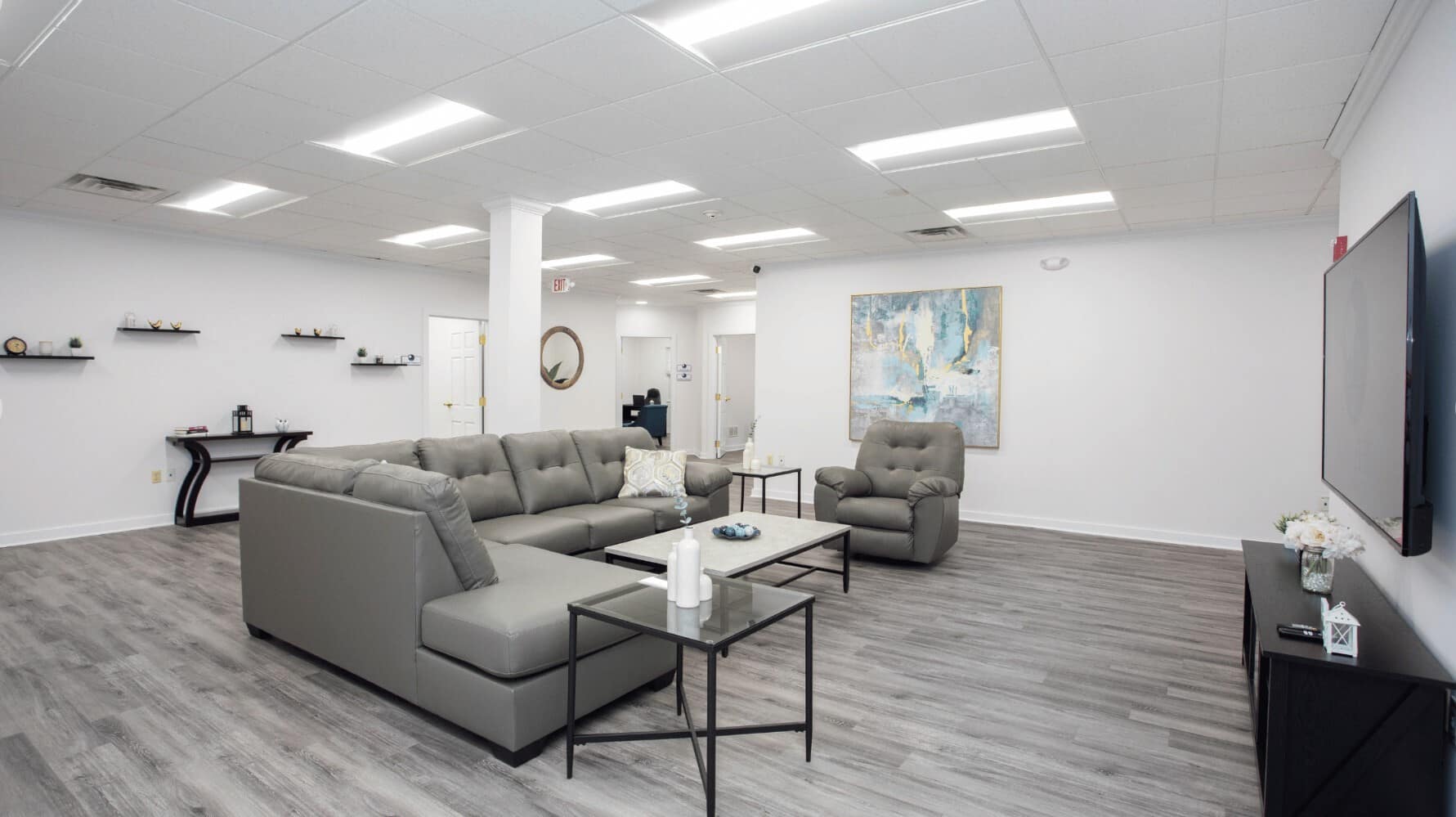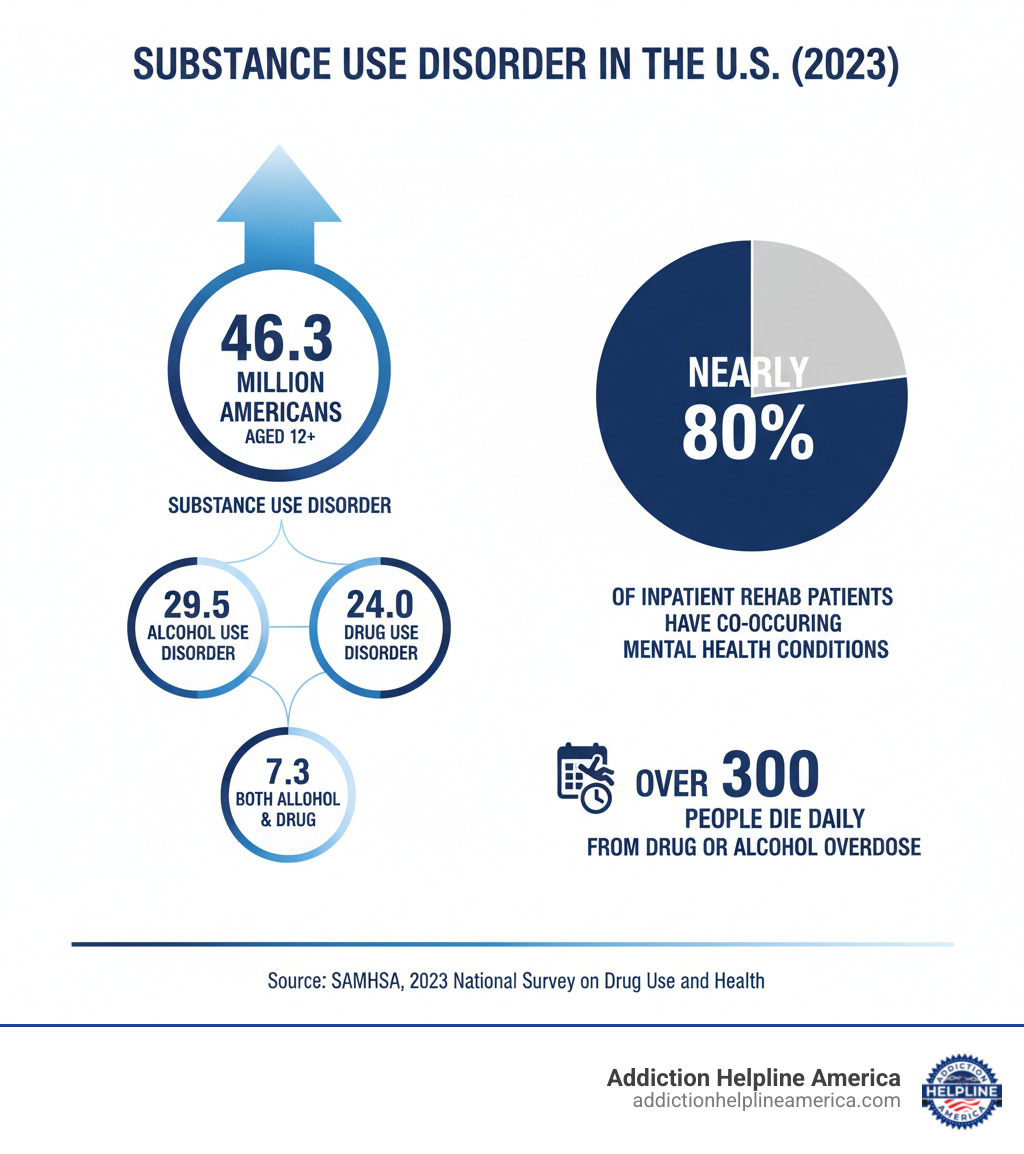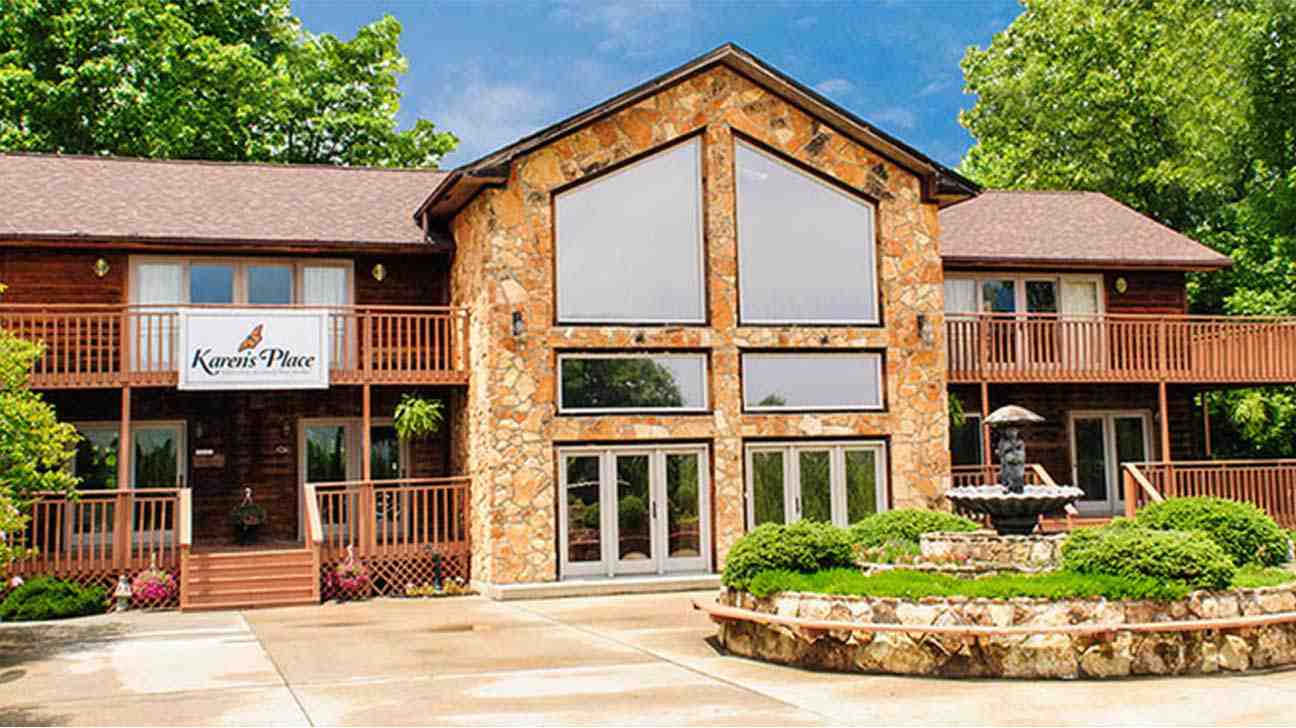
Why Finding the Right Inpatient Program Matters
An alcohol and drug rehab inpatient program is a residential treatment option where you live at a facility 24/7 for intensive substance use disorder care. It’s designed for individuals who need:
- Medical supervision during detox.
- 24/7 structured support in a trigger-free environment.
- Integrated mental health care for co-occurring conditions.
- Intensive therapy and holistic treatments.
- A fresh start away from environments that enable substance use.
In 2023, 46.3 million Americans aged 12 or older had a substance use disorder. That’s roughly 1 in 6 people. Alarmingly, over 300 people die every day in America from drug or alcohol overuse. If you or a loved one are facing this, you’re not alone, and there is hope.
The path to recovery begins with understanding your options. While not the only choice, inpatient rehab is often the most effective for those with severe addiction, unsafe home environments, or previous failed outpatient attempts. Nearly 80% of people entering inpatient rehab also have co-occurring mental health conditions, and modern programs are equipped to treat both simultaneously.
This guide will walk you through what happens in an alcohol and drug rehab inpatient program, how to know if you need one, what it costs, and how to find a reputable facility.
Addiction Helpline America has years of experience connecting people with the right treatment resources. Our team guides you through selecting an alcohol and drug rehab inpatient program that aligns with your unique needs and recovery goals.

Common alcohol and drug rehab inpatient program vocab:
Understanding Inpatient Rehab: What It Is and Who It’s For

An alcohol and drug rehab inpatient program is a residential treatment experience where you live at a facility to focus entirely on recovery. Unlike outpatient treatment, you are there around the clock. This 24/7 structured environment is about protection, removing you from the people, places, and stressors that trigger substance use.
Medical supervision is a cornerstone of inpatient care, which is crucial during detox when withdrawal can be dangerous. You’re also surrounded by peers on the same path, building a community of support that becomes a valuable part of recovery.
| Factor | Inpatient Rehab | Outpatient Rehab |
|---|---|---|
| Intensity | High – 24/7 structured care | Lower – scheduled appointments |
| Environment | Residential – live at facility | Home-based – attend sessions then return home |
| Cost | Higher due to housing and constant care | Lower – no room and board |
| Ideal Candidate | Severe addiction, unsafe home environment, co-occurring disorders, previous relapse | Mild to moderate addiction, stable home, strong support system, work/family obligations |
What are the benefits of inpatient rehab?
The immersive nature of inpatient care means your entire day revolves around recovery. Every activity is designed to help you understand your addiction and build tools to overcome it.
Safety during detox is a primary benefit. Withdrawal from alcohol, benzodiazepines, or opioids can be medically dangerous. In an alcohol and drug rehab inpatient program, medical staff manage symptoms and intervene if complications arise. You’re not going through it alone.
The community aspect is powerful. Living with others in recovery creates strong bonds and a support network that often lasts for years. You share meals, therapy, and victories, fostering a sense of family.
Most importantly, inpatient rehab allows you to focus completely on healing, free from daily distractions. This dedicated focus often makes the difference for those with severe addiction. Research shows higher success rates are associated with inpatient treatment for severe substance use disorders, especially when followed by quality aftercare.
For those who need significant support but can’t commit to residential care, Intensive Outpatient Treatment offers a strong alternative.
How do I know if I need inpatient treatment?
Deciding if you need inpatient care can be difficult, but a professional assessment can provide clarity. There are also clear indicators that it might be your best path.
- Severe substance use disorder: If addiction has severely impacted your health, relationships, career, or legal status, a higher level of care is needed.
- Co-occurring mental health issues: Nearly 80% of people in inpatient rehab have issues like depression, anxiety, or PTSD. These conditions feed off each other, and breaking the cycle requires integrated treatment that addresses both simultaneously.
- Unsafe home environment: A home filled with triggers, active users, or enabling family members makes recovery difficult. Physical distance can create the mental space needed for change.
- Previous relapses: If you’ve tried outpatient treatment or quitting on your own without lasting success, the 24/7 support of inpatient care may be what you need.
- Other signs: These include overwhelming cravings, severe withdrawal symptoms, or complex addictions involving multiple substances.
Still unsure? Take a Substance Use Self-Test to better understand your situation.
What are the different types of inpatient facilities?
Not all alcohol and drug rehab inpatient programs are the same, which means you can find one that fits your specific needs and budget.
- Luxury rehab centers offer high-end amenities like private rooms and gourmet meals alongside excellent clinical care for maximum comfort and privacy.
- Executive programs cater to professionals, providing workspaces and internet access to allow for continued work responsibilities during treatment.
- State-funded centers provide essential, evidence-based care for those with limited financial resources, proving effective treatment doesn’t require a luxury price tag.
- Gender-specific programs offer a focused environment for men or women to address addiction and related issues without the distractions of a mixed-gender setting.
- Age-specific programs tailor treatment to groups like adolescents or older adults, addressing their unique life-stage challenges.
- Faith-based treatment centers integrate spiritual principles, such as developing a relationship with a higher power, into the recovery process.
- Specialized programs serve specific populations like veterans, LGBTQIA+ individuals, or first responders, with an understanding of their unique challenges.
To explore your options, check out our Find the Best Addiction Rehab Guide.
A Look Inside an Alcohol and Drug Rehab Inpatient Program

Stepping into an alcohol and drug rehab inpatient program means entering a therapeutic community designed for healing. The structured, predictable daily routine provides safety and stability, which are often lost during active addiction. You’ll be surrounded by peers who understand your journey, creating bonds that can last a lifetime. The entire environment, from evidence-based practices to holistic therapies, is part of the healing process.
If you’re ready to take the next step, our Get Help Now: Complete Guide can walk you through the process from your first call.
What services and therapies are typically offered?
A quality alcohol and drug rehab inpatient program blends evidence-based treatments with holistic approaches to treat the whole person.
- Medical detoxification: For physical dependence, medical detox is often the first step. Staff monitor you 24/7, manage withdrawal symptoms, and ensure your safety and comfort.
- Individual therapy: Regular one-on-one sessions with a licensed therapist help you explore the roots of your addiction. Common approaches include Cognitive Behavioral Therapy (CBT) to change negative thought patterns and Dialectical Behavior Therapy (DBT) to manage intense emotions.
- Group counseling: Sharing with peers in group counseling creates a powerful sense of belonging and reduces isolation. You’ll practice new communication skills and receive feedback in a supportive setting.
- Family therapy: Addiction affects the whole family. Family therapy helps loved ones understand the disease, learn supportive behaviors, and begin rebuilding trust.
- Holistic therapies: Therapies like yoga, art therapy, nutritional planning, and fitness activities support healing for the mind, body, and spirit.
- Educational workshops: These workshops teach the science of addiction, relapse prevention strategies, and practical life skills for maintaining sobriety.
For a deeper look at the full range of services available, visit More on Rehabilitation Services.
How does integrated mental health care work?
Addiction rarely travels alone. Nearly 80% of people in an alcohol and drug rehab inpatient program also have co-occurring mental health conditions like depression, anxiety, or PTSD.
This is why dual diagnosis treatment is essential. Modern inpatient programs understand that addiction and mental health are intertwined and must be treated simultaneously.
Upon arrival, a comprehensive assessment identifies any co-occurring disorders. You’ll have access to psychiatry services, where medical doctors can diagnose conditions and manage medications. This is handled with care to ensure it supports your recovery. Many programs also provide trauma-informed care, recognizing that unresolved trauma often fuels addiction.
An integrated, unified treatment plan is the key. Your entire team coordinates care, understanding how your mental health and substance use affect each other. This whole-person approach leads to significantly better outcomes.
To understand more about this integrated approach, explore Learn about co-occurring disorders.
What is the daily routine like?
The structure of an alcohol and drug rehab inpatient program can be surprisingly comforting after the chaos of addiction.
- Mornings start early with a communal breakfast, followed by group meetings, educational lectures, and therapy sessions (individual or group).
- Afternoons begin after a community lunch and are for skill-building workshops, holistic therapies like yoga or art, and time for individual reflection and therapy assignments.
- Evenings include dinner and a final group meeting or a 12-step program session. Free time for reading or talking with peers is followed by a set lights-out time to promote healthy sleep patterns.
This predictable routine isn’t restrictive—it’s liberating. It removes daily chaos and allows you to focus completely on recovery, one supportive day at a time.
The Practicalities: Duration, Cost, and Finding a Program

Once you decide on an alcohol and drug rehab inpatient program, practical questions about duration, cost, and finding a reputable facility arise. The admissions process is designed to be smooth and respectful. It starts with a phone assessment to discuss your history and needs. From there, an intake specialist will help verify your insurance and discuss program options. Our guide on How to Get Into Rehab offers a detailed walkthrough.
What is the typical length of stay in an alcohol and drug rehab inpatient program?
The length of stay in an alcohol and drug rehab inpatient program varies based on individual needs, addiction severity, and the presence of co-occurring disorders.
- 30-day programs are common and provide a solid foundation for detox, stabilization, and learning essential coping skills.
- 60-day programs allow more time to address the underlying causes of substance use and practice new behaviors in a supportive setting.
- 90-day programs are often recommended for severe addiction or multiple relapses, as research shows longer stays correlate with better long-term outcomes.
Some individuals may benefit from long-term programs lasting several months. The best facilities focus on clinical milestones rather than rigid timelines, meaning your progress is based on your readiness, not the calendar. For more on treatment timelines, see our Rehab Duration Complete Guide.
How is payment and insurance handled for inpatient rehab?
Cost is a major concern, but many options exist to pay for an alcohol and drug rehab inpatient program. Prices vary by location, amenities, and length of stay.
- Health Insurance: Most PPO and HMO plans cover substance use disorder treatment, thanks to federal laws. Many facilities are in-network with major providers, reducing out-of-pocket costs. Admissions teams can verify your insurance benefits to clarify coverage.
- Medicare & Medicaid: Medicare covers inpatient services, while Medicaid coverage varies by state. Always confirm with the facility directly.
- Private Pay & Financing: For those without insurance, private pay is an option. Many centers offer payment plans, financing, or a sliding scale fee based on income.
- Non-Profit Options: Organizations like The Salvation Army often provide services at little to no cost. SAMHSA also offers helpful tips for how to pay for treatment.
How do I find a reputable alcohol and drug rehab inpatient program?
Choosing the right alcohol and drug rehab inpatient program is a critical decision. Here’s what to look for to ensure high-quality care:
- Accreditation: Look for accreditation from organizations like the Joint Commission (JCAHO) or CARF, which indicates high standards for safety and quality.
- Licensed Staff: Ensure the staff includes licensed medical doctors, therapists, and certified addiction counselors.
- Evidence-Based Treatment: The program should use scientifically proven therapies like CBT and DBT.
- Individualized Care: Quality facilities create a customized care plan based on a thorough assessment of your needs.
- Integrated Mental Health Care: Choose a program that treats co-occurring disorders like depression or anxiety simultaneously with addiction.
- Aftercare Planning: A strong program includes comprehensive aftercare planning for continued support after you leave.
- Transparency: Reputable facilities are upfront about services, costs, and philosophy. Be wary of programs that guarantee a “cure.”
Addiction Helpline America takes the guesswork out of this process. We connect you with trusted, high-quality programs from our nationwide network. Use the Addiction Helpline America treatment locator to get started.
The Journey After Inpatient Treatment
Completing an alcohol and drug rehab inpatient program is a major achievement, but it’s the start of a lifelong recovery journey. The real work begins as you transition back into the world, using your new skills to prevent relapse and build a supportive community. Strong aftercare planning and family involvement are key to turning short-term sobriety into lasting change.
What is the role of family in inpatient rehab?
Addiction affects the whole family, so their involvement in recovery is vital. A quality alcohol and drug rehab inpatient program helps repair these relationships and builds a stronger foundation for everyone.
- Family therapy sessions provide a safe, mediated space to heal wounds, improve communication, and rebuild trust.
- Educational programs for families teach the science of addiction and help shift enabling behaviors to healthy support. Many programs also connect families with support groups like Al-Anon.
- The goal is to teach communication skills and healthy boundaries that support long-term recovery for the entire family system. As The Salvation Army notes, when individuals are rehabilitated, “children get their parents back. People get their lives back.”
What happens after completing an inpatient program?
The time after an alcohol and drug rehab inpatient program is critical, which is why a solid aftercare plan is essential. Before you leave, your team will create a personalized discharge plan to guide your next steps.
- Step-down care provides a transition with structured therapy while allowing more independence. This may include a Partial Hospitalization Program (PHP) or an Intensive Outpatient Program (IOP).
- Sober living homes offer a structured, supportive, and drug-free environment where you live with others in recovery.
- Alumni programs provide a peer support network to keep you connected to the recovery community through events and mentorship.
- Ongoing therapy and support groups like Alcoholics Anonymous (AA) or Narcotics Anonymous (NA) are the backbone of long-term recovery, helping you stay grounded in your sobriety.
These aftercare components help you build a life where sobriety is sustainable. To learn more, read What Is Rehab Aftercare?.
Frequently Asked Questions about Inpatient Rehab
Can inpatient rehab address co-occurring mental health disorders?
Yes. Quality alcohol and drug rehab inpatient program facilities provide integrated care (also called dual diagnosis treatment) for co-occurring mental health disorders. Nearly 80% of people in inpatient rehab deal with conditions like depression, anxiety, or PTSD. Treating addiction and mental health simultaneously with a coordinated team leads to much better outcomes than addressing them separately. This whole-person approach is a hallmark of modern, effective treatment. For more information, learn about co-occurring disorders.
What are the success rates of inpatient rehab?
Defining “success rates” for an alcohol and drug rehab inpatient program is complex, as recovery is a personal journey. Success isn’t just about continuous sobriety; it’s also measured by improved quality of life, better physical and mental health, rebuilt relationships, and reduced relapse frequency. While addiction is a chronic condition without a “cure,” recovery is absolutely possible. An inpatient program provides the intensive foundation for this lifelong journey, and success depends on the individual’s commitment, aftercare engagement, and the quality of treatment received.
Where can I find immediate help for a crisis?
If you or a loved one is in crisis—experiencing suicidal thoughts or a mental health emergency—immediate, confidential help is available 24/7.
Call or text 988 to reach the 988 Suicide & Crisis Lifeline. Trained counselors are available to provide free, confidential support.
For treatment referrals and to explore options for an alcohol and drug rehab inpatient program, contact Addiction Helpline America. Our team provides personalized guidance to connect you with the resources you need to start your recovery journey.
Your Path to Recovery Starts Here
Seeking help for addiction is a brave and crucial decision. An alcohol and drug rehab inpatient program is about reclaiming your life. It provides 24/7 medical supervision, an immersive therapeutic environment, integrated mental health care, and a supportive community to build a foundation for lasting recovery.
We understand that concerns about cost, insurance, and the unknown can be overwhelming, but you don’t have to steer this alone.
At Addiction Helpline America, we offer free, confidential, and personalized guidance. We connect you with quality treatment centers from our nationwide network that fit your specific needs, whether you’re looking for a faith-based program, luxury accommodations, or state-funded options.
Your journey doesn’t have to start with all the answers. It starts with a single decision to try. You deserve a life free from the grip of addiction—a life of health, hope, and purpose. Recovery is possible, and we’re here to help you find the path that leads to it.
Don’t wait another day. Explore different types of treatment programs to find your fit, or reach out to our team directly for personalized guidance. Your recovery story starts here.
Our helpline is 100%
free & confidential
If you or someone you care about is struggling with drug or alcohol addiction, we can help you explore your recovery options. Don’t face this challenge alone—seek support from us.
Programs
Resources
Will my insurance
cover addiction
treatment?
We're ready to help
Find the best
drug or alcohol treatment
center
Are you or a loved one struggling with addiction? Call today to speak to a treatment expert.












